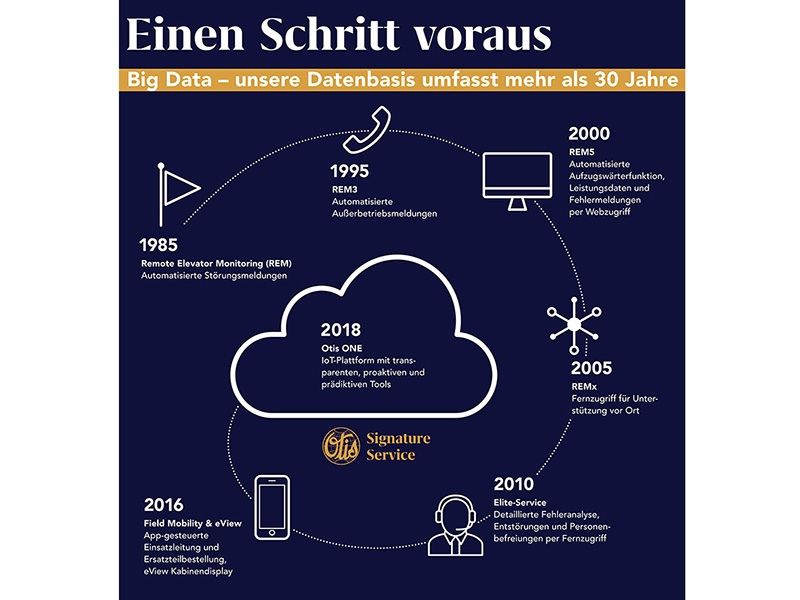Digital platform for the German market
The keywords digitalisation, predictive maintenance and proactive service – Otis will implementing this trend now. Otis Germany boss answered LIFTjournal’s questions in an exclusive interview.
The worldwide biggest group in the industry is now launching "Otis one" in Germany. As a result, the leading world group can collect and evaluate the data from 300,000 of its lifts on this platform for hardware, software and cloud-based IoT (Internet of Things)-solutions.
In this way, not only are operating interruptions recorded faster, but in the best case even predicted – i.e. building operators are proactively informed even faster and more transparently. Under the brand name "Signature Service", Otis provides customers a completely networked and personalised service in combination with "Otis one". Udo Hoffmann, Chairman of the Management Board of Otis Germany, answered LIFTjournal’s questions in an exclusive interview.
"Otis one", Signature Service – Mr. Hoffmann, what is really new about these offers?
Hoffmann: What is above all new is the personalisation. With "Otis one", we offer completely networked services. Our customers are provided with all relevant information at any time via our customer portal. We monitor your lifts in real time, report proactively on any irregularities and can despatch a service technician before any operating interruptions occur.
"Otis one" is the hardware and software that provides us with the opportunity to generate the data needed for this purpose and then coordinate it with our customers. Our existing service offers were integrated and enriched in the Signature Service umbrella brand; "Otis one" is the platform for hard- and software and for IoT-based services under this umbrella.
Do you have enough data to foresee malfunctions?
Hoffmann: Actually, Otis has been generating data with its REM system for about 30 years and using it for remote diagnostics. Since 2010, we have even been able to eliminate operating interruptions via remote intervention and free trapped passengers. The beautiful thing is that we have digitalised this data and can also have a perspective based on them - this is an advantage we have over everyone else.
What are the advantages for the operator?
Hoffmann: It is above all about improving customer service. Ninety percent of the complaints that land on my desk are about inadequate customer information. But with "Otis one" and Signature Service, we automatically transfer lots of information to the operators; this means they always know exactly what is happening to their lift at the moment. Consequently, the operator is provided with all of the relevant information at all times. Now they can design their cockpit themselves as customers. Moreover, they have an interface where all the data of the building comes together - heating, climate, etc.
Who actually owns this data?
Hoffmann: The technical data belongs to us; we generated it with our system in the building. Since we are aware of the sensitivity of the subject of data sovereignty, we have included this explicitly in our contracts. But we pass the data on to customers, we don’t conceal anything.
Is this transparency vis-à-vis the customer something special?
Hoffmann: It was not as common in the past, but it will prevail. Information is a customer retention instrument. It also helps converting the service models from the old to the new era.
What does that mean?
Hoffmann: Digitalisation is not only producing new professions, but also new service offers. It may lead to us not just dealing with the lift, but with the entire building. Buildings are becoming higher and more complex than ever due to the concentration of cities. Owners may not want to have 100 lifts in a building with 10,000 occupants, because that’s space they can’t rent.
So it’s not just about mobility?
Hoffmann: Correct. Today, it is restricted to the building and the lift. What’s going to happen in the future? The subject of transport within and between buildings will become increasingly important very fast.
What opportunities do small and medium-sized companies have in view of this development?
Hoffmann: They have the same opportunities as the big companies. I don’t see any disadvantages there. There are over 500 lift companies in Germany. They exist, because the market needs them.
The interview was held by Ulrike Lotze
www.otis.com






















Write a comment